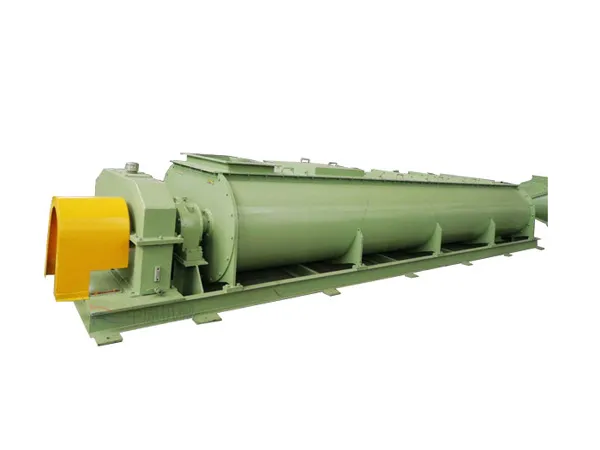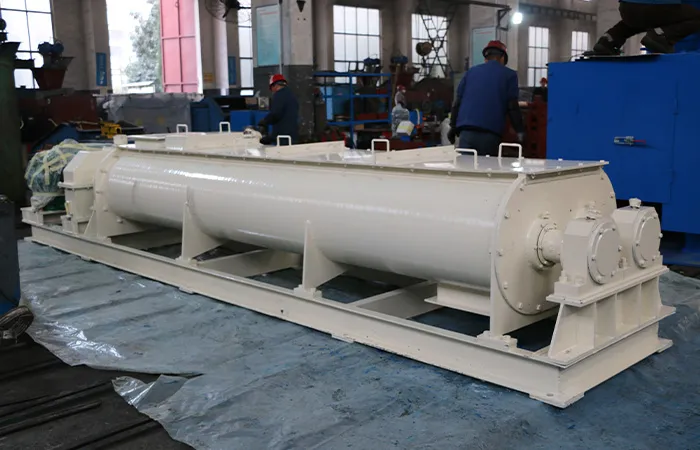

-
Products
-
Application


A double shaft mixer, often called a twin-shaft mixer or pugmill, is a high-intensity, industrial mixing machine designed to blend a wide variety of materials quickly and homogeneously.
Its core feature is the presence of two parallel, counter-rotating shafts equipped with multiple paddles, blades, or arms. These shafts are housed within a W-shaped or U-shaped trough. This design creates a powerful and efficient mixing action that is ideal for demanding applications, especially those involving aggregates, sludges, powders, and pastes.Maintaining a double shaft mixer is crucial for its longevity, efficiency, and safe operation.

Cleaning is Paramount:
Thorough Washout: After every use, especially with concrete or sticky materials, thoroughly clean the mixer. Use water, and for stubborn buildup, consider adding gravel to the water and running the mixer for 5-30 minutes.
Remove Residue: Scrape off any remaining material from the interior, especially the mixing arms, blades, and shaft. Hardened concrete or material buildup reduces mixing efficiency and can damage components.
Discharge Door: Clean deposits around the discharge door to ensure smooth opening and closing.
Non-Wetted Parts: Be careful when cleaning non-wetted components to avoid damage from liquids.
Lubrication Checks:
Central Lubrication System: Ensure the central lubrication pump is working properly. Check for any leaks in connection points and refill the lubricant if necessary.
Shaft End Seal: This is a critical area. Check the lubricating oil pump for normal oiling daily. Ensure there's oil in the oil pump oil cup and the pump's cartridge is normal. If there's an issue, stop immediately and troubleshoot. If manual oiling is needed, do it every 30 minutes to keep the shaft end sufficiently lubricated.
Other Lubrication Points: Check other lubrication points like spindle bearings, discharge door bearings, motor bottom plate rotating shaft, and hydraulic cylinder rotating shaft.
Visual Inspection:
Leaks: Look for any oil, grease, or other fluid leaks, which could indicate seal or gasket problems.
Unusual Noises/Vibrations: Listen for any strange sounds or vibrations, which can be early indicators of a problem. Stop operation immediately if detected.
Loose Bolts/Connections: Check for any loose bolts on blades, stirring arms, and lining plates, and tighten them.
Wear and Tear: Quickly inspect for any obvious signs of damage, cracks, or corrosion on external components like the motor, drive shafts, and blades.
Control Panel: Check the alarm status on the control panel.
Lubrication:
Check the oil level of the reducer and hydraulic pump.
Belt Tension:
Check and adjust the tension of the driving belt using the belt stretching unit. Ensure proper tension to avoid premature wear or slippage.
Wear Parts:
Visually inspect seals, bearings, and couplings for wear or damage. Replace any seals that show cracks or damage.
Check the alignment of mixing blades and adjust as needed.
Material Buildup:
Perform a longer, more thorough cleaning with water and rock to remove any deeper buildup.

Gearbox: Check the oil level in the gearbox.
Hydraulic Oil: Check the cleanliness and color of the hydraulic oil.
Electrical Components: Remove dust and debris from the electric control box. Inspect wiring and connections for signs of wear or issues.
Consumable Parts: Check whether all mixing arms and scrapers are loose. Tighten any loose bolts.
Shaft Alignment: Conduct monthly shaft alignment checks. Use laser alignment systems for accuracy if possible.
Bearings: Inspect and replace worn-out bearings. Keep mounting bolts tightened.
Reducer Oil Change: Replace the reducer oil. For the first use, change it after 50 hours, then every 1000 hours or at least every half year.
Agitator Mounting Shaft: Take apart and check the agitator mounting shaft.
Sealing Ring: Measure the sealing ring's thickness and determine if it needs replacement.
Deep Cleaning: Perform a deep clean of the mixer.
PLC Program/Panel: Upgrade if there's a version update.
Complete Overhaul: Completely disassemble and overhaul the mixer.
Replace Wear Parts: Replace parts that wear out quickly, such as bearings, sealing rings, oil seals, mixing blades, and liner plates (replace if thickness is less than 3mm).
Control System: Carry out a detailed check-up on the control system to ensure it's calibrated correctly and look for any interference.
Hydraulic System Oil: Change hydraulic system oil every 2000 hours or at least once a year.
General Best Practices & Tips:
Follow Manufacturer Guidelines: Always refer to the specific maintenance manual provided by the mixer's manufacturer. This is the most crucial tip, as requirements can vary between models.
Proper Lubricants: Use the recommended type and amount of lubricant for each component. Using the wrong lubricant can cause significant damage.
Don't Overload: Avoid overloading the mixer beyond its rated capacity, as this puts undue strain on the motor, paddles, and drive components, leading to premature wear and potential breakdowns.
Avoid Over-Operation: Don't operate the mixer for longer than necessary to achieve the desired mix quality.
Train Operators: Ensure all operators are properly trained on safe and correct operation and maintenance procedures.
Preventative Maintenance Program: Implement a structured preventative maintenance program with scheduled inspections and tasks.
Keep Records: Maintain detailed records of all maintenance activities, including inspections, repairs, and part replacements. This helps track wear patterns and plan future maintenance.
Original Parts: When replacing parts, use original factory or certified supplier parts.
Safety First: Always turn off and disconnect the power supply (lockout/tagout) before performing any cleaning, inspection, or maintenance activities. Wear appropriate personal protective equipment (PPE).
Storage: Store the mixer in a dry, covered, and secure environment to prevent rust, corrosion, theft, or vandalism.
By consistently following these maintenance tips, you can significantly extend the lifespan of your double shaft mixer, minimize downtime, improve efficiency, and ensure a safer working environment.

Official Agent of ZY MINING in Russia.
Please enter here.
Add: Luoxin Industrial Zone,Luoyang City,Henan Province P.R.C.
Tel: +86-379-67313306
E-mail: gloria@zyksjx.com